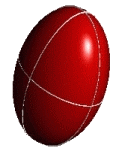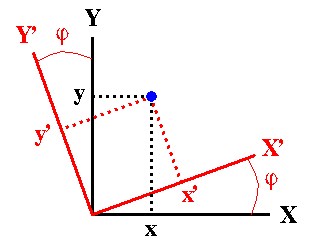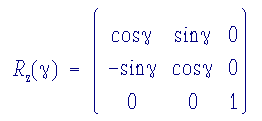[Uni Tübingen] - [Mat.-Nat. Fakultät] - [Fachbereich Chemie] - [Anorg. Chemie] - [Klaus Eichele] - [NMR Ramblings] - [Tensor Conventions] - Euler Angles
 |
Euler AnglesContents: [Euler angles] - [Rotation matrices] - |
Euler Angles
The triplet of Euler angles (α, β, γ) is useful to describe rotations or relative orientations of orthogonal coordinate systems. Unfortunately, their definition is not unique and in the literature there are as many different conventions as authors. The convention employed here is one of the more common ones [1]. All rotations are in a counter-clockwise fashion (right-handed, mathematically positive sense).
 |
The Euler angles (α, β, γ) relate two orthogonal coordinate systems having a common origin. The transition from one coordinate system to the other is achieved by a series of two-dimensional rotations. The rotations are performed about coordinate system axes generated by the previous rotation step (the step-by-step procedure is illustrated in the topic Rotation Matrices). The convention used here is that α is a rotation about the Z axis of the initial coordinate system. About the y' axis of this newly generated coordinate system a rotation by β is performed, followed by a rotation by γ about the new z axis. Given the Euler angles, the step-by-step procedure illustrates how to move from one coordinate system to the other. However, given the two coordinate systems, how can we determine the Euler angles relating them? This is described in the topic Determining Euler Angles. The usual ranges for α, β, γ are: 0 <= α <= 360 0 <= β <= 180 0 <= γ <= 360 |
Rotation Matrices
Rotations or transformations from one coordinate system into another are conveniently described by the triplet of Euler angles. Using the Euler angles, this three-dimensional problem can be dissected into a sequence of two-dimensional rotations, whereby in each rotation one axis remains invariant.
 |
2D Analogy: In order to simplify the problem, let us start with a two-dimensional rotation: Suppose the coordinates, (x,y), of a point in the two-dimensional XY system are known, but we are actually interested in knowing the coordinates of this point in another coordinate system, X'Y', which is related to the XY system by a counter-clockwise rotation by an angle φ. As the figure indicates, the coordinates of the given point in the new coordinate system will be: x' = x cos φ + y sin φ y' = -x sin φ + y cos φ or, in matrix notation:
(Problems seeing how those transformations are obtained? Have a look at my page on rotations.) |
 |
Start: Coincidence Now, transferred to a three-dimensional problem, the goal will be to describe the coordinates in a final rotated system (x,y,z) which is related to some initial coordinate system (X,Y,Z) by the Euler angles. The final system is developed in three steps, each step involving a rotation described by one Euler angle. At the start, both coordinate systems, (X,Y,Z) and (x(1), y(1), z(1)), shall be coincident. |
 |
1st Rotation The first rotation involves the Euler angle α. The x(1), y(1), z(1) axis system is rotated about the Z axis through an angle α counterclockwise relative to X,Y,Z to give the new system x(2), y(2), z(2). It is clear from the figure that this rotation mixes the coordinates along X and Y, completely analogous to the two-dimensional rotation described above, while the coordinate along Z remains unaffected. The rotation matrix to describe this operation is given by: 
|
 |
2nd Rotation The second rotation involves the Euler angle β. The x(2), y(2), z(2) axis system is rotated about the y(2) axis through an angle β counterclockwise to generate the new coordinate system x(3), y(3), z(3). Analogous to the first Euler rotation, this mixes the coordinates along x(2) and z(2), while the coordinate along y(2) remains unaffected. This operation also generates a line of nodes parallel to the direction of y(2). The rotation matrix to describe this operation is given by: 
|
 |
3rd Rotation The last rotation involves the Euler angle γ. The x(3), y(3), z(3) axis system is rotated about the z(3) axis through an angle γ counterclockwise to generate the final coordinate system x, y, z. Analogous to the first Euler rotation, this mixes the coordinates along x(3) and y(3), while the coordinate along z(3) remains unaffected. The rotation matrix to describe this operation is given by: 
|
The combined effect of these three rotations is given by this transformation matrix: |
|
Determining Euler Angles
Given the relative orientations of two coordinate systems, how do we go about determining the Euler angles relating them?
First, we need to decide which coordinate system to take as the reference coordinate system, X,Y,Z, and which one as derived coordinate system, x,y,z. Because the Euler transformations allow to switch between coordinate systems easily, it does not really matter which one is selected.
 |
The angle β is simply the angle between the z axes of both coordinate systems. The angle α is the angle between the X axis of the reference coordinate system and the projection of z into the X,Y plane. Finally, γ is the angle between the y axis and the line of nodes. Computationally, we can work your way backwards from the components of the above transformation matrix: |
Conventions
Unfortunately, there are different conventions for the Euler angles relating two coordinate systems:
- the ZYZ order, described above, is used by Arfken [2], Spiess [3], Mehring [4], Narita et al. [5], Freude and Haase [6], Dye et al. [7], and by my programs and SIMPSON by M. Bak.
- the ZXZ order is used by Stauss [8], Baugher and coworkers [9], Goldstein [10], Power et al. [11]
- in addition, we need to distinguish between active and passive transformations, we can think of it as bringing the reference system into coincidence with the derived system or bringing the derived system into coincidence with the reference system by applying the Euler rotations [3b].
Note that rotation about sequentially newly generated axes produces the same result as rotations by the same angles about the fixed original axes, if the order of angles is reversed: RZ(α) RY(β) RZ(γ) (cf. Mehring's book, appendix [4]).
The problem of different Euler angle conventions has also been addressed by Mulliken in his Report on Notation for the Spectra of Polyatomic Molecules [12]:
»It has been suggested by several people that it would be desirable, in the theoretical discussion of rigid rotor functions, to agree on a single standard way of choosing Eulerian angles. However, since any such standardization should have the agreement of other groups in addition to the spectroscopists, it is proposed that such a cooperative agreement be sought at a later date.«
It seems that such an agreement has not been achieved yet!
References
| [1] | M. E. Rose, Elementary Theory of Angular Momentum, Wiley: New York 1957. |
| [2] | G. Arfken, Mathematical Methods for Physicists, 3rd. ed., Academic Press: New York 1985. |
| [3] | H. W. Spiess, In NMR Basic Principles and Progress; P. Diehl, E. Fluck, R. Kosfeld, Eds.; Springer Verlag, Berlin, 1978, Vol. 15. K. Schmidt-Rohr, H. W. Spiess, Multidimensional Solid-State NMR and Polymers, Academic Press: London 1994. |
| [4] | M. Mehring, Principles of High Resolution NMR in Solids; 2nd ed.; Springer-Verlag, Berlin, 1983. |
| [5] | K. Narita, J.-I. Umeda, H. Kusumoto, J. Chem. Phys. 1966, 44, 2719; DOI 10.1063/1.1727118. |
| [6] | D. Freude, J. Haase, In: NMR Basic Principles and Progress; P. Diehl, E. Fluck, H. Guenther, R. Kosfeld, J. Seelig, Eds.; Springer Verlag, Berlin, 1993, Vol. 29. |
| [7] | J. L. Dye, A. S. Ellaboudy, J. Kim, Solid State NMR of Quadrupolar Nuclei; In: "Modern NMR Techniques and Their Application in Chemistry", Practical Spectroscopy Series Vol. 11; A. I. Popov, K. Hallenga, Eds.; Marcel Dekker, Inc., New York, 1991, pp 217-322. |
| [8] | Stauss, J. Chem. Phys. 1967, 40, 1988; DOI 10.1063/1.1725432. |
| [9] | J. F. Baugher, P. C. Taylor, T. Oja, P. J. Bray, J. Chem. Phys. 1969, 50, 4914; DOI 10.1063/1.1670988. |
| [10] | H. Goldstein, Classical Mechanics, 2nd. ed.; Addison-Wesley, Reading, MA, 1980. |
| [11] | W. P. Power, R. E. Wasylishen, S. Mooibroek, B. A. Pettitt, W. Danchura, J. Phys. Chem. 1990, 94, 591; DOI 10.1021/j100365a019. |
| [12] | R. S. Mulliken, J. Chem. Phys. 1955, 23, 1997; DOI 10.1063/1.1740655. |
[ Anorg. Chemie ] | [ Go Home ] | webm@ster | last modified: 20.03.2020



